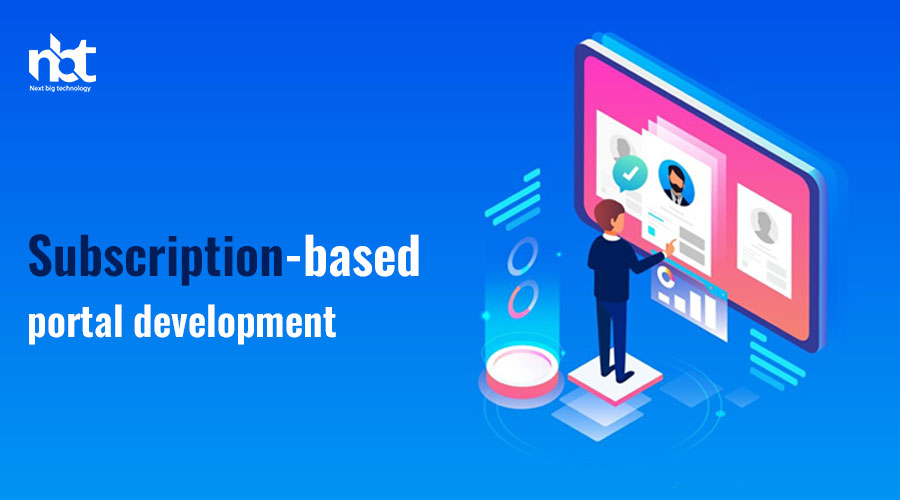Table of Contents
Subscription-based portal development Services
In today’s digital age, businesses are constantly seeking innovative ways to engage with their customers and streamline their operations. Subscription-based portal development services have emerged as a game-changer, offering companies a powerful platform to deliver content, services, and products to their users through convenient subscription models. These portals not only enhance user experience but also open up new avenues for revenue generation and business growth.
Subscription-based portal development services encompass a wide range of features and functionalities tailored to meet the specific needs of businesses across various industries. From content subscription platforms to software-as-a-service (SaaS) solutions, these portals can be customized to deliver diverse offerings efficiently and effectively.
One of the key benefits of subscription-based portals is their ability to foster long-term relationships with customers. By offering valuable content or services on a recurring basis, businesses can build loyalty and keep customers engaged over time. This recurring revenue model also provides a predictable stream of income, allowing businesses to better plan and allocate resources.
Moreover, subscription-based portals enable businesses to gather valuable insights into customer behavior and preferences. Through analytics and user data, companies can optimize their offerings, personalize content, and target marketing efforts more effectively. This data-driven approach not only enhances the user experience but also enables businesses to stay ahead of the competition in today’s dynamic marketplace.
Furthermore, subscription-based portal development services empower businesses to scale their operations efficiently. Whether it’s adding new features, expanding to new markets, or accommodating a growing user base, these portals offer the flexibility and scalability needed to support business growth.
From a technical standpoint, subscription-based portals are built using robust technologies and frameworks that ensure reliability, security, and performance. Whether it’s handling payment transactions securely or managing user accounts seamlessly, these portals are designed to deliver a smooth and frictionless user experience.
How to Create a Subscription-based portal development
In today’s digital age, the subscription-based business model has emerged as a lucrative avenue for entrepreneurs seeking sustainable revenue streams. From streaming services to online courses, subscription-based portals offer businesses the opportunity to cultivate a loyal customer base while ensuring consistent revenue. If you’re considering venturing into this realm, here’s a comprehensive guide on how to create a subscription-based portal development.
- Market Research and Idea Validation: Before diving into development, conduct thorough market research to identify potential niches and assess competition. Validate your idea by gauging interest through surveys, focus groups, or landing pages to collect feedback from potential customers.
- Define Your Value Proposition: Clearly articulate the value proposition your subscription-based portal offers. Identify the unique benefits subscribers will gain, whether it’s exclusive content, convenience, cost savings, or a combination thereof.
- Choose the Right Platform: Select a platform that aligns with your technical requirements and budget. Options range from building a custom portal from scratch using programming languages like HTML, CSS, and JavaScript, to utilizing subscription management platforms such as Shopify, WooCommerce, or Substack.
- Design User-Friendly Interface: A seamless user experience is paramount for retaining subscribers. Invest in intuitive navigation, responsive design, and visually appealing aesthetics to enhance engagement and satisfaction.
- Subscription Models and Pricing Strategy: Determine the subscription models that best suit your business, such as monthly, annual, or tiered plans offering varying levels of access. Develop a pricing strategy that balances affordability with profitability, considering factors like value proposition, competition, and target audience.
- Content Creation and Curation: Invest in high-quality content that adds value to your subscription offering. Whether it’s premium articles, exclusive videos, or downloadable resources, compelling content is key to attracting and retaining subscribers.
- Secure Payment Gateway Integration: Ensure seamless and secure payment processing by integrating reliable payment gateways like PayPal, Stripe, or Authorize.Net. Prioritize encryption and compliance with relevant data security standards such as PCI DSS to safeguard sensitive customer information.
- Personalization and Engagement: Leverage data analytics to personalize the user experience and deliver targeted recommendations based on subscriber preferences and behavior. Implement features like user profiles, personalized recommendations, and interactive elements to foster engagement and retention.
- Customer Support and Community Building: Provide responsive customer support channels to address subscriber inquiries, feedback, and technical issues promptly. Foster a sense of community among subscribers through forums, discussion boards, or exclusive events to encourage interaction and loyalty.
- Continuous Optimization and Iteration: Monitor key performance metrics such as subscriber churn rate, conversion rate, and revenue growth to identify areas for improvement. Embrace a culture of continuous optimization and iteration, refining your subscription-based portal based on user feedback and market trends.
Why Should You Go for Subscription-based portal development
In today’s digital landscape, businesses are constantly seeking innovative ways to engage with their audience and stay ahead of the competition. One such avenue that has gained considerable traction is subscription-based portal development. From streaming services to software platforms, the subscription model has proven to be a game-changer for businesses across various industries. But what exactly makes subscription-based portal development so compelling? Let’s delve into the myriad of benefits it offers:
- Recurring Revenue Streams: Perhaps the most obvious advantage of subscription-based portal development is the establishment of recurring revenue streams. Instead of relying on one-time purchases, businesses can secure a steady flow of income from subscribers who pay on a monthly or annual basis. This predictable revenue model provides stability and allows for better financial planning and forecasting.
- Enhanced Customer Loyalty: By offering a subscription-based portal, businesses can cultivate a loyal customer base. Subscribers often feel a sense of commitment to the service, incentivizing them to continue their subscriptions over time. Additionally, features such as personalized content recommendations and exclusive access can further deepen customer loyalty and engagement.
- Flexibility and Scalability: Subscription-based portals offer flexibility for both businesses and users. Businesses can easily scale their offerings by introducing different subscription tiers or adding new features over time. Meanwhile, users have the flexibility to choose subscription plans that best suit their needs, with the option to upgrade or downgrade as their requirements evolve.
- Continuous Value Delivery: Unlike traditional products or services, subscription-based portals prioritize continuous value delivery. Businesses are incentivized to consistently enhance their offerings to retain subscribers and attract new ones. This focus on ongoing improvement ensures that users receive fresh content, updates, and features, keeping them engaged and satisfied.
- Data-driven Insights: Subscription-based portals provide valuable insights into user behavior and preferences. Businesses can leverage data analytics to gain a deeper understanding of their audience, enabling them to tailor content and marketing strategies accordingly. By harnessing this data-driven approach, businesses can optimize their offerings and maximize subscriber retention.
- Lower Barrier to Entry: The subscription model often presents a lower barrier to entry for users compared to upfront purchases. By spreading the cost over time, subscribers can access premium content or services without a significant upfront investment. This accessibility can attract a wider audience and drive adoption rates, ultimately benefiting the bottom line.
- Adaptability to Market Trends: In today’s rapidly evolving market landscape, adaptability is key to staying relevant. Subscription-based portals offer businesses the flexibility to adapt to changing market trends and consumer preferences swiftly. Whether it’s pivoting to offer new content formats or integrating emerging technologies, subscription models enable businesses to stay agile and competitive.
Market Prospects of Subscription-based portal development and Platforms
In today’s digital age, subscription-based portal development and platforms have emerged as a lucrative avenue for businesses looking to capitalize on recurring revenue streams while offering valuable services to their customers. With the ever-growing demand for convenient access to information, entertainment, and services, subscription-based portals have garnered significant attention from both entrepreneurs and established enterprises. In this article, we delve into the market prospects of subscription-based portal development and platforms, highlighting key trends, opportunities, and challenges.
Rising Demand for Personalized Content and Services: One of the primary drivers fueling the growth of subscription-based portals is the increasing consumer preference for personalized content and services. Whether it’s streaming platforms like Netflix and Spotify or subscription-based news outlets and fitness apps, users are willing to pay for access to tailored experiences that cater to their specific interests and needs. This trend has created a vast market for subscription-based portal development across various industries, including media, entertainment, e-learning, healthcare, and more.
Diverse Revenue Models: Subscription-based portals offer businesses a diverse range of revenue models to monetize their offerings. From monthly or annual subscription plans to tiered pricing structures and pay-per-use models, companies can choose the approach that best aligns with their target audience and value proposition. Additionally, the subscription economy enables businesses to foster long-term relationships with customers, leading to higher customer lifetime value and reduced churn rates.
Opportunities in Niche Markets: While established players dominate certain sectors of the subscription-based portal market, there are ample opportunities for niche players to carve out their own space. By focusing on specialized content or services tailored to specific demographics or interests, startups and entrepreneurs can differentiate themselves in a crowded market and attract a loyal subscriber base. Whether it’s a niche fitness app targeting yoga enthusiasts or a subscription-based cooking portal catering to vegan cuisine, niche offerings have the potential to thrive in today’s competitive landscape.
Technological Advancements: Advancements in technology, particularly in areas such as cloud computing, artificial intelligence, and data analytics, have greatly facilitated the development and management of subscription-based portals. Cloud-based infrastructure allows for scalable and cost-effective deployment, while AI-powered algorithms enable personalized recommendations and content curation. Furthermore, data analytics tools provide valuable insights into user behavior, allowing businesses to optimize their offerings and enhance customer satisfaction.
Challenges and Considerations: Despite the promising opportunities, there are several challenges and considerations that businesses must address when venturing into subscription-based portal development. Competition is fierce, with numerous players vying for market share in popular segments such as streaming media and e-learning. Moreover, maintaining subscriber engagement and retention requires continuous innovation and investment in content development and platform enhancements. Additionally, businesses must prioritize data privacy and security to build trust and credibility with their subscribers in an increasingly regulated environment.
Essential Features of a Subscription-based portal development+
In today’s digital age, subscription-based portals have become a cornerstone for businesses aiming to establish a recurring revenue stream while providing valuable services or content to their users. Whether it’s streaming platforms, e-learning portals, or software services, the success of such platforms hinges on their ability to offer a seamless user experience coupled with essential features tailored to meet the needs of both businesses and consumers.
Here are the key features that are essential for the development of a subscription-based portal:
- User-Friendly Interface: A user-friendly interface is paramount for retaining subscribers. The portal should be intuitive, easy to navigate, and visually appealing. Users should be able to access content or services with minimal effort, fostering a positive user experience that encourages them to stay subscribed.
- Secure Payment Gateway: Integration with a secure payment gateway is crucial to facilitate smooth transactions and ensure the security of users’ financial information. Whether it’s credit card payments, PayPal, or other payment methods, users should feel confident in the safety of their transactions.
- Personalized Content Recommendations: Leveraging data analytics and AI algorithms, subscription-based portals can offer personalized content recommendations based on users’ preferences, viewing history, or interaction patterns. This not only enhances user engagement but also increases the likelihood of subscribers finding value in the content they access.
- Flexible Subscription Plans: Providing flexibility in subscription plans allows users to choose the option that best suits their needs and budget. Whether it’s monthly, yearly, or tiered subscription plans with varying levels of access, offering flexibility empowers users to tailor their subscription experience.
- Mobile Responsiveness: With an increasing number of users accessing content on mobile devices, ensuring the portal is mobile-responsive is essential. A seamless experience across devices enhances accessibility and convenience, catering to the preferences of modern consumers.
- Robust Content Management System (CMS): A robust CMS empowers administrators to efficiently manage and update content, add new features, and monitor user activity. This flexibility is essential for keeping the portal dynamic and responsive to evolving user needs and market trends.
- Engagement and Interaction Features: Incorporating features such as discussion forums, live chats, or interactive quizzes fosters community engagement and encourages users to interact with both the content and fellow subscribers. This sense of belonging can significantly enhance the overall user experience and increase retention rates.
- Data Analytics and Reporting: Implementing robust analytics tools allows administrators to gain insights into user behavior, preferences, and engagement metrics. These insights can inform strategic decisions, content optimization efforts, and marketing campaigns to drive growth and retention.
- Seamless Integration with Third-Party Services: Integrating with third-party services such as CRM systems, email marketing platforms, or social media channels enhances the portal’s functionality and expands its reach. Seamless integration enables a cohesive user experience across various touchpoints.
- Continuous Updates and Support: Regular updates, bug fixes, and proactive customer support are vital for maintaining the portal’s performance and addressing any issues that may arise. Providing excellent customer support fosters trust and loyalty among subscribers, ensuring long-term success.
Advanced Features Subscription-based portal development
In today’s digital landscape, businesses are constantly seeking innovative ways to enhance user engagement and monetize their online platforms. Subscription-based portals have emerged as a lucrative model, offering a host of advanced features to users while ensuring a steady stream of revenue for businesses. This article explores the realm of advanced features in subscription-based portal development and how they can revolutionize the user experience.
- Personalized User Experience: Subscription-based portals allow for the creation of personalized user experiences tailored to individual preferences. Advanced algorithms analyze user behavior and preferences to deliver customized content, recommendations, and notifications, thereby enhancing user engagement and retention.
- Exclusive Content Access: One of the key benefits of subscription-based portals is the provision of exclusive content reserved for subscribers. Whether it’s premium articles, videos, or downloadable resources, offering exclusive content incentivizes users to subscribe and unlocks additional revenue streams for businesses.
- Advanced Analytics and Insights: Subscription-based portals provide access to advanced analytics and insights, enabling businesses to gain valuable data about user behavior, preferences, and engagement patterns. This data-driven approach allows for informed decision-making, content optimization, and targeted marketing strategies.
- Interactive Features and Community Building: Integrating interactive features such as discussion forums, live chats, and virtual events fosters community engagement and strengthens the sense of belonging among subscribers. These interactive elements not only add value to the subscription offering but also encourage user participation and loyalty.
- Multi-platform Accessibility: Advanced subscription-based portals are designed to be accessible across multiple devices and platforms, including desktops, smartphones, and tablets. This multi-platform accessibility ensures seamless user experiences, regardless of the device being used, thereby maximizing reach and engagement.
- Integrated Payment Gateways and Billing Systems: Seamless payment processing and subscription management are essential components of subscription-based portals. Integration with secure payment gateways and robust billing systems ensures hassle-free transactions and subscription renewals, enhancing user convenience and satisfaction.
- AI-powered Recommendation Engines: Leveraging artificial intelligence (AI) and machine learning algorithms, subscription-based portals can deploy sophisticated recommendation engines that analyze user preferences and behavior to deliver personalized recommendations. This not only improves content discovery but also drives engagement and retention.
- Scalability and Flexibility: Advanced subscription-based portal development prioritizes scalability and flexibility, allowing businesses to adapt to changing market dynamics and evolving user needs. Whether it’s scaling infrastructure to accommodate growing user bases or introducing new features and functionalities, flexibility is key to sustaining long-term success.
Subscription-based portal development Timelines
In today’s digital era, subscription-based portals have become a cornerstone for businesses aiming to deliver exclusive content, services, or products to their customers. Whether it’s a streaming platform, an e-learning portal, or a software-as-a-service (SaaS) solution, the development of such portals requires careful planning and adherence to timelines to ensure timely launch and optimal functionality. Let’s delve into the intricacies of subscription-based portal development timelines to understand the process better.
- Initial Planning and Research (1-2 Weeks): Before diving into development, thorough planning and research are imperative. This phase involves defining the portal’s objectives, target audience, features, and monetization strategies. Conducting market research to understand competitors and user preferences is vital in shaping the portal’s direction.
- Design and Prototyping (2-3 Weeks): Once the requirements are clear, the design phase begins. UI/UX designers work on creating wireframes, mockups, and prototypes to visualize the portal’s layout and functionality. Feedback loops with stakeholders ensure alignment with the desired user experience.
- Development (6-10 Weeks): Development kicks off once the design is approved. This phase involves coding the front-end and back-end functionalities of the portal. Front-end developers focus on user interfaces, while back-end developers handle server-side logic, databases, and integrations with payment gateways and other third-party services.
- Testing and Quality Assurance (2-4 Weeks): Rigorous testing is conducted to identify and rectify bugs, usability issues, and performance bottlenecks. Quality assurance (QA) engineers perform functional testing, compatibility testing across devices and browsers, security audits, and user acceptance testing (UAT) to ensure the portal meets the desired standards.
- Integration and Deployment (1-2 Weeks): Once the portal passes all tests and approvals, it’s ready for deployment. This involves setting up servers, configuring databases, and integrating third-party APIs or services. Continuous integration and deployment (CI/CD) pipelines streamline the deployment process, ensuring smooth rollouts without disruptions.
- Launch and Post-launch Optimization (Ongoing): The launch phase marks the portal’s official release to the public. However, the work doesn’t end here. Continuous monitoring and optimization are crucial to address any post-launch issues, gather user feedback, and iterate on features to enhance the portal’s performance and user satisfaction.
- Maintenance and Updates (Ongoing): Regular maintenance and updates are essential to keep the portal secure, stable, and up-to-date with evolving technology trends and user demands. This includes patching vulnerabilities, adding new features, optimizing performance, and ensuring compatibility with new devices or platforms.
How Much Does It Cost to Build a Subscription-based portal development?
In today’s digital age, subscription-based portals have become increasingly popular among businesses aiming to provide valuable content or services to their users on a recurring basis. Whether it’s streaming platforms, online courses, or software services, building a subscription-based portal requires careful planning and consideration, especially when it comes to costs.
So, how much does it actually cost to develop a subscription-based portal? Let’s break it down.
- Platform Selection: The first step in building a subscription-based portal is selecting the right platform. You can choose between building a custom portal from scratch or utilizing existing platforms like WordPress, Shopify, or customizing a CMS (Content Management System) like Drupal or Joomla. The cost will vary depending on your choice, with custom development typically being more expensive but offering more flexibility and scalability.
- Development Costs: Custom development involves designing the portal’s user interface (UI) and user experience (UX), developing backend functionality for user registration, subscription management, content delivery, payment integration, and more. Development costs can range from a few thousand dollars to tens of thousands, depending on the complexity of the portal and the hourly rates of developers.
- Content Management System (CMS): If you opt for a CMS like WordPress, you’ll need to consider the cost of themes, plugins, and customizations to tailor the portal to your specific requirements. While CMS platforms are more cost-effective upfront, they may require ongoing maintenance and updates, which can add to the overall cost over time.
- Subscription Management and Payment Integration: Implementing subscription management features such as user registration, login, subscription plans, recurring billing, and payment gateways is crucial for a subscription-based portal. Depending on your requirements, you may need to integrate with third-party services like Stripe, PayPal, or use in-built solutions provided by the platform. These integrations come with their own costs, including setup fees, transaction fees, and subscription fees.
- Hosting and Infrastructure: Hosting costs depend on factors like server resources, bandwidth, security features, and scalability. You can choose between shared hosting, VPS (Virtual Private Server), dedicated hosting, or cloud hosting services like AWS, Google Cloud, or Azure. Cloud hosting offers scalability and flexibility but can be more expensive compared to traditional hosting options.
- Security and Compliance: Ensuring the security of your subscription-based portal and compliance with data protection regulations like GDPR (General Data Protection Regulation) or CCPA (California Consumer Privacy Act) is essential. This may involve implementing SSL certificates, encryption, regular security audits, and compliance assessments, which can add to the overall cost.
- Maintenance and Support: Once your subscription-based portal is up and running, you’ll need to budget for ongoing maintenance, updates, bug fixes, and customer support. Depending on your resources and expertise, you can either handle maintenance internally or outsource it to a third-party development agency.
How to Create a Subscription-based portal development – Team and Tech Stack
In the dynamic landscape of online business, subscription-based portals have emerged as powerful tools for monetization, customer engagement, and recurring revenue generation. Whether you’re looking to launch a streaming service, a curated content platform, or a software-as-a-service (SaaS) solution, creating a subscription-based portal requires careful planning, the right team, and a robust tech stack. Let’s delve into the essential elements needed to bring your subscription-based portal to life.
Understanding the Concept
Before diving into development, it’s crucial to have a clear understanding of what your subscription-based portal will offer and who your target audience is. Conduct market research to identify gaps in the market, understand competitors, and define your unique value proposition. Determine the types of subscriptions you’ll offer, pricing models, and the features and content your portal will provide to subscribers.
Building the Team
Creating a subscription-based portal is a multidisciplinary endeavor that requires expertise in various domains. Here are key roles to consider for your development team:
- Project Manager: Oversees the entire development process, ensuring deadlines are met, and the project stays within budget.
- UI/UX Designer: Designs the user interface and experience to ensure intuitive navigation and engaging interactions.
- Frontend Developer: Translates design mockups into responsive, functional user interfaces using HTML, CSS, and JavaScript frameworks like React or Angular.
- Backend Developer: Builds the server-side logic, database architecture, and APIs necessary for the portal’s functionality using technologies such as Node.js, Python (Django or Flask), or Ruby on Rails.
- Database Administrator: Manages the database infrastructure, ensuring data integrity, security, and scalability.
- Quality Assurance (QA) Engineer: Conducts rigorous testing to identify and fix bugs, ensuring a seamless user experience.
- DevOps Engineer: Manages the deployment, monitoring, and scaling of the portal, often utilizing cloud services like AWS or Azure.
Depending on the complexity of your portal, you may need to expand or consolidate these roles accordingly. Collaboration, communication, and teamwork are essential for success.
Selecting the Tech Stack
Choosing the right technologies is pivotal for the performance, scalability, and security of your subscription-based portal. Here’s a recommended tech stack:
- Frontend:
- Framework: React.js or Angular for robust frontend development.
- Styling: CSS preprocessors like Sass or LESS for efficient styling.
- State Management: Redux for managing complex application states.
- Backend:
- Framework: Node.js with Express.js for building scalable server-side applications.
- Database: MongoDB or PostgreSQL for flexible and scalable data storage.
- Authentication: JSON Web Tokens (JWT) for secure user authentication.
- Payment Gateway Integration: Stripe or PayPal for seamless subscription management and payments.
- Infrastructure:
- Cloud Hosting: AWS or Google Cloud Platform for scalable infrastructure and services.
- Content Delivery Network (CDN): Cloudflare or Akamai for fast content delivery to users worldwide.
- Monitoring: Tools like Prometheus and Grafana for monitoring system health and performance metrics.
- Development Tools:
- Version Control: Git for collaborative development and version control.
- Continuous Integration/Continuous Deployment (CI/CD): Jenkins or GitLab CI for automated build and deployment pipelines.
- Project Management: Jira, Trello, or Asana for efficient project tracking and task management.
Subscription-based portal development Process
In today’s digital age, subscription-based portals have emerged as a cornerstone for businesses looking to establish recurring revenue streams while offering valuable services to their customers. These portals serve as a gateway for users to access exclusive content, services, or products in exchange for a subscription fee. Whether you’re planning to develop a subscription-based portal for content delivery, software as a service (SaaS), or e-commerce, understanding the development process is crucial for success.
- Market Research and Conceptualization: Before diving into development, thorough market research is essential to identify potential niches, target audiences, and competitors. Determine the unique value proposition your portal will offer and conceptualize its features and functionalities based on market demand and user preferences.
- Define Subscription Model and Pricing Strategy: Choose the subscription model that aligns with your business goals and target audience preferences. Options include tiered pricing, freemium models, pay-per-use, or flat-rate subscriptions. Establish competitive pricing strategies that reflect the value provided by your portal while remaining attractive to potential subscribers.
- Design and User Experience (UX): Engaging and intuitive design is paramount to the success of a subscription-based portal. Work closely with designers and UX experts to create a visually appealing interface that enhances user experience and encourages subscription conversion. Ensure seamless navigation, clear calls-to-action, and personalized recommendations to keep users engaged.
- Development and Integration: Utilize robust development frameworks and technologies to build the backend infrastructure of your portal. Integrate secure payment gateways, user authentication systems, content management systems (CMS), and any additional features specific to your portal’s functionality. Prioritize scalability and flexibility to accommodate future growth and updates.
- Content Creation and Curation: Populate your portal with high-quality, valuable content that resonates with your target audience. Whether it’s articles, videos, courses, or digital products, ensure consistency and relevance to maintain subscriber satisfaction. Implement content curation strategies to continuously refresh and update offerings to retain subscribers.
- Testing and Quality Assurance: Thoroughly test all aspects of your portal, including functionality, performance, compatibility, and security. Conduct user acceptance testing (UAT) to gather feedback and identify any usability issues or bugs. Address any issues promptly to ensure a smooth and seamless user experience upon launch.
- Marketing and Launch: Develop a comprehensive marketing strategy to generate buzz and attract subscribers to your portal. Utilize digital marketing channels such as social media, email marketing, influencer partnerships, and search engine optimization (SEO) to reach your target audience. Offer enticing promotions or exclusive incentives to incentivize early adoption.
- Analytics and Optimization: Implement analytics tools to track key performance indicators (KPIs) such as subscriber growth, churn rate, engagement metrics, and revenue generation. Analyze data insights to identify areas for optimization and enhancement. Continuously iterate on your portal based on user feedback and market trends to drive long-term success.
Next Big Technology – Your Trusted Subscription-based portal development Partner
In the rapidly evolving landscape of technology, staying ahead of the curve is paramount for businesses aiming to thrive in the digital age. One avenue that has gained significant traction in recent years is subscription-based portals. These portals offer businesses a unique opportunity to engage with their audience, provide value-added services, and establish recurring revenue streams. However, navigating the complexities of portal development can be daunting without the right partner by your side.
Enter the Next Big Technology – your trusted subscription-based portal development partner. With a proven track record of delivering innovative solutions tailored to the specific needs of our clients, we are committed to helping businesses harness the full potential of subscription-based models.
At Next Big Technology, we understand that each business is unique, and there is no one-size-fits-all solution when it comes to portal development. That’s why we take a personalized approach to every project, working closely with our clients to understand their goals, challenges, and vision for their subscription-based portal.
Our team of experienced developers, designers, and strategists is well-versed in the latest technologies and best practices in subscription-based portal development. Whether you’re looking to create a membership platform, e-learning portal, content distribution platform, or any other subscription-based service, we have the expertise and capabilities to bring your vision to life.
From conceptualization and design to development and deployment, we handle every aspect of the portal development process with meticulous attention to detail and a focus on delivering results that exceed expectations. Our agile development methodology ensures that we can adapt to changing requirements and deliver high-quality solutions on time and within budget.
But our commitment to your success doesn’t end with the launch of your subscription-based portal. We provide ongoing support and maintenance to ensure that your portal remains secure, scalable, and optimized for performance. Additionally, we offer strategic guidance and insights to help you maximize the value of your portal and drive user engagement and retention.
Partnering with Next Big Technology means more than just building a subscription-based portal – it means unlocking new opportunities for growth, innovation, and success for your business. With our expertise and dedication, we empower businesses to stay ahead of the competition and thrive in the digital era.
So if you’re ready to take your business to the next level with a subscription-based portal, look no further than Next Big Technology. Contact us today to learn more about our services and how we can help you achieve your goals. Together, let’s build the next big thing in technology.
Enterprise Subscription-based portal development
In the dynamic landscape of digital commerce and service delivery, enterprises are constantly seeking innovative ways to engage customers, streamline operations, and drive revenue. One powerful solution gaining traction is the development of subscription-based portals tailored to enterprise needs. These portals offer a centralized platform for delivering services, content, and products to a subscribed user base, fostering ongoing relationships and recurring revenue streams. Let’s delve into the realm of enterprise subscription-based portal development and explore its key benefits and considerations.
Understanding Enterprise Subscription-Based Portals
At its core, an enterprise subscription-based portal is a digital gateway that provides access to exclusive content, services, or products in exchange for a recurring subscription fee. These portals are highly customizable, allowing enterprises to tailor the user experience to meet the unique needs and preferences of their target audience. Whether it’s delivering premium content, software-as-a-service (SaaS) solutions, or personalized shopping experiences, subscription-based portals offer a scalable and cost-effective way to monetize offerings while enhancing customer loyalty and retention.
Key Benefits of Enterprise Subscription-Based Portals
- Recurring Revenue Streams: By implementing a subscription-based model, enterprises can generate predictable, recurring revenue streams, providing stability and scalability for long-term growth strategies.
- Enhanced Customer Engagement: Subscription-based portals foster ongoing engagement with customers, offering personalized experiences, exclusive content, and value-added services that keep users coming back for more.
- Data-Driven Insights: Through analytics and user data collected via subscription portals, enterprises gain valuable insights into customer behavior, preferences, and trends, enabling informed decision-making and targeted marketing strategies.
- Scalability and Flexibility: Subscription-based portals are inherently scalable, allowing enterprises to easily adjust offerings, pricing, and features to accommodate changing market dynamics and business needs.
- Competitive Advantage: By providing unique and valuable offerings through subscription portals, enterprises can differentiate themselves in the market, attract new customers, and maintain a competitive edge.
Considerations for Development
While the benefits of enterprise subscription-based portals are compelling, successful implementation requires careful planning and execution. Here are some key considerations for development:
- User Experience (UX) Design: Prioritize intuitive navigation, responsive design, and personalized experiences to enhance user engagement and satisfaction.
- Content and Offerings: Curate high-quality, relevant content and offerings that align with the needs and interests of your target audience, ensuring ongoing value and retention.
- Subscription Management: Implement robust subscription management systems to handle billing, invoicing, payment processing, and subscription lifecycle management seamlessly.
- Security and Compliance: Prioritize data security and compliance with regulations such as GDPR and PCI DSS to safeguard sensitive customer information and maintain trust.
- Integration and Scalability: Ensure compatibility and integration with existing systems and technologies, while also designing for scalability to accommodate future growth and expansion.
Top Subscription-based portal development Companies
In today’s digital age, subscription-based portals have become the cornerstone of various industries, offering convenience, personalized experiences, and continuous value to users. Whether it’s streaming services, e-learning platforms, or software solutions, subscription portals have reshaped how businesses engage with their audiences. However, the success of these portals heavily relies on the expertise of development companies behind them. Here’s a roundup of the top subscription-based portal development companies leading the way in revolutionizing online services:
-
-
Next Big Technology:
Next Big Technology is one of the top development companies for the high-quality development of mobile apps and web development services. They have having experienced in-house team of developers who provide top-notch development services according to the business requirements. NBT provides highly business-oriented services and implements all the latest and trending tools and technologies. They always work hard to deliver a top-notch solution at an affordable cost. They are having experience of more than 13 years and delivered lots of projects around the globe to businesses and clients.
NBT is highly focused on providing top-notch development solutions at a very affordable cost. By using their market experience and development experience, they are delivering proper solutions to clients and various industries for their custom requirements.
Location: India, USA, UK, Australia
Hourly Rate :< $25 per Hour
Employees: 50 – 249
Focus Area
- Mobile App Development
- App Designing (UI/UX)
- Software Development
- Web Development
- AR & VR Development
- Big Data & BI
- Cloud Computing Services
- DevOps
- E-commerce Development
Industries Focus
- Art, Entertainment & Music
- Business Services
- Consumer Products
- Designing
- Education
- Financial & Payments
- Gaming
- Government
- Healthcare & Medical
- Hospitality
- Information Technology
- Legal & Compliance
- Manufacturing
- Media
-
- Amazon Web Services (AWS): As a subsidiary of Amazon, AWS has played a pivotal role in powering some of the most popular subscription-based portals across various industries. With its cloud computing services, AWS enables companies to build scalable, secure, and reliable subscription platforms. From content delivery to database management, AWS offers a comprehensive suite of tools for developing subscription portals that can handle millions of users seamlessly.
- Spotify Technology S.A.: Spotify has revolutionized the music streaming industry with its personalized subscription-based platform. Behind its dynamic playlists and intelligent recommendations is Spotify Technology S.A., a company known for its expertise in music streaming technology. By leveraging machine learning and data analytics, Spotify Technology S.A. continuously enhances the user experience, making it one of the top choices for music enthusiasts worldwide.
- Udemy, Inc.: Udemy has emerged as a leading platform for online learning, offering a vast array of courses across diverse subjects. Behind its user-friendly interface and comprehensive course catalog is Udemy, Inc., a company dedicated to making education accessible to all through subscription-based models. With features like personalized recommendations and interactive learning tools, Udemy, Inc. continues to shape the future of online education.
- Salesforce.com, Inc.: Salesforce is renowned for its customer relationship management (CRM) solutions, but it also offers robust capabilities for developing subscription-based portals. With Salesforce’s platform, companies can build and customize subscription portals tailored to their specific needs, whether it’s managing subscriptions, processing payments, or analyzing customer data. With its scalability and flexibility, Salesforce.com, Inc. empowers businesses to thrive in the subscription economy.
FAQs on Subscription-based portal development
In the digital age, subscription-based portals have emerged as indispensable tools for businesses aiming to provide exclusive access, personalized content, and recurring revenue streams. However, delving into the realm of subscription-based portal development can raise numerous questions. To shed light on this dynamic field, let’s explore some frequently asked questions (FAQs) that can help you navigate through the process:
- What exactly is a subscription-based portal?
- A subscription-based portal is an online platform that offers users access to premium content, services, or products in exchange for a recurring fee. It provides a gated environment where subscribers can enjoy exclusive benefits tailored to their needs.
- What are the key features of a successful subscription-based portal?
- Essential features include user authentication and authorization, content management, subscription management, payment processing, analytics and reporting, personalized user experiences, and robust security measures to safeguard sensitive data.
- How can I monetize a subscription-based portal?
- Monetization strategies typically involve offering subscription plans with varying levels of access and benefits, implementing tiered pricing models, providing upselling opportunities, and leveraging additional revenue streams such as advertising, sponsorships, or affiliate partnerships.
- What technologies are commonly used for building subscription-based portals?
- Popular technologies include content management systems (CMS) like WordPress, subscription management platforms such as Stripe or PayPal, customer relationship management (CRM) tools like Salesforce, and development frameworks like Laravel or Ruby on Rails.
- How do I ensure a seamless user experience (UX) on my subscription-based portal?
- Prioritize intuitive navigation, responsive design for compatibility across devices, personalized content recommendations based on user preferences and behavior, streamlined registration and subscription processes, and proactive customer support to address any issues promptly.
- What are some common challenges associated with subscription-based portal development?
- Challenges may include maintaining subscriber retention, combating churn, ensuring scalability to accommodate growing user bases, addressing security concerns related to handling sensitive payment information, and staying abreast of evolving regulatory compliance requirements.
- How do I market and promote my subscription-based portal effectively?
- Employ a multi-channel marketing approach encompassing social media marketing, content marketing, email marketing campaigns, search engine optimization (SEO) strategies, influencer partnerships, and targeted advertising to reach and engage your target audience.
- What metrics should I track to gauge the success of my subscription-based portal?
- Key performance indicators (KPIs) to monitor include subscriber growth rate, churn rate, average revenue per user (ARPU), customer lifetime value (CLV), retention rate, engagement metrics (such as time spent on the portal and frequency of visits), and conversion rates for marketing campaigns.
- How can I optimize the pricing strategy for my subscription-based portal?
- Conduct market research to understand your target audience’s willingness to pay, analyze competitors’ pricing models, offer tiered subscription plans with different pricing tiers and features to cater to varying customer segments, and periodically reassess and adjust pricing based on feedback and performance data.
- What are some best practices for ensuring the long-term success of a subscription-based portal?
- Continuously innovate and update your offerings to provide ongoing value to subscribers, foster a sense of community and loyalty among users, solicit and act upon feedback to address pain points and enhance the user experience, and cultivate strong relationships with subscribers through personalized communication and rewards programs.
Thanks for reading our post “Subscription-based portal development”. Please connect with us to learn more about the Subscription-based portal.
























